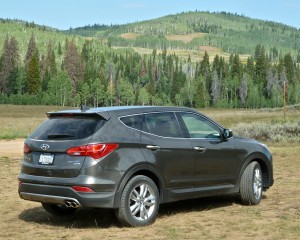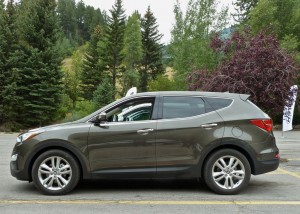Two models lead the way to Santa Fe
By John Gilbert
PARK CITY, UTAH — Maybe it’s simply a translation issue, from South Korea to the United States, but the Santa Fe has never been introduced in Santa Fe, New Mexico. Hyundai also has a compact SUV named Tucson, which has never been introduced in Arizona. Go figure.
Nobody, however, is pleading for geographic logic in opposition to the site of Park City, Utah, where the 2013 Santa Fe Sport was introduced, complete with side trips to Sundance and the Olympic Park training facility.
In setting the stage for the increased luxury of the vehicle, we were dropped off 45 minutes west of Salt Lake City at the luxurious Montage Resort, nestled up in the trees at 8,347 feet of mountain altitude. It was the perfect place to show off the ability of the 2013 Santa Fe Sport’s turbocharged 2.0-liter engine, which easily coped with such a high-altitude drain on power.
The decidedly upscale revision to the Santa Fe has a flashy, bright chrome grille serving notice that its third generation intends to show its maturity by stepping above and beyond the subtle but efficient current model to become two vehicles in one.
The 2.0-turbo scored well in all maneuvers sending the Santa Fe Sport across some twisting mountain roads, and some rougher gravel back roads, although we didn’t do any off-roading that would qualify as being worse than a rural Northern Minnesota driveway. We only got the chance to drive the Santa Fe Sport with its 2.0-turbocharged 4-cylinder engine, while still to come is the same vehicle with the 2.4 GDI (gas direct-injection), both of those with compact 184.6-inch length. In a curious bit of name-calling, the actual vehicle called Santa Fe will stretch into an elongated 193.1-inch, three-row-seat version with a 3.3-liter V6, as it becomes a vehicle for all reasons. The new Santa Fe is not only a luxurious, upscale replacement of the current Santa Fe as the Sport, but it also grows to longer form to replace the larger Veracruz — an impressive top-end model, which will disappear in favor of the Santa Fe’s expanded intentions.
All Santa Fe models come with front-wheel drive or all-wheel drive, which is reflected in their price structure. The Santa Fe Sport 2.4 has a base price of $24,450 (FWD) and $26,200 (AWD); the Sport 2.0-Turbo runs from $27,700 (FWD) to $29,450 (AWD). Pricing on the elongated model will follow its introduction.
Hyundai has been on such a remarkable run of hot-selling new cars through the 2011 and 2012 model years — including Sonata. Genesis, Equus, Veloster, Elantra, Accent, plus Genesis Coupe, Elantra Coupe, and Elantra GT — that the Korean company’s SUV fleet has been overlooked.
The compact Tucson, midsize Santa Fe, and large Veracruz gave Hyundai a trio of competent sport-utility vehicles, even as the impressive cars have thrust the company into the spotlight for consumers at all levels — to say nothing of rival manufacturers the world over. Kia, which is Hyundai’s partner and uses Hyundai technology, platforms and drivetrains, has more prominent SUVs, with its Sorento a more stylish version of the Santa Fe, and its Sportage a bit more stylish than the Tucson.
The new Santa Fe signals a change in corporate strategy. For starters, John Krafcik, Hyundai Motor America’s president, said he started out as an engineer, and since reducing weight in a vehicle is the toughest challenge, the new Santa Fe starts with high marks. “The 5-passenger Santa Fe Sport is 266 pounds lighter than the outgoing Santa Fe, and the 7-passenger (Santa Fe) is 397 pounds lighter than the Veracruz,” Krafcik said.
Hyundai has a huge advantage over all other auto companies by owning its own steel company, greatly lowering its expense of high-grade steel, which can be made thinner and therefore lighter while still stronger than thicker and heavier lower-grade steel. The current Santa Fe had high-strength steel in its roof, rollover beams and “C” pillars. The new model goes from 7.8 to 37.7 percent high-strength steel, and makes the new Santa Fe Sport 15.7 percent more rigid. It feels more solid and stable, and clearly is much quieter than its predecessor.
The new design is an extension of the “fluidic sculpture” from Hyundai’s newest generation of cars, and has a bright chrome hexagonal grille that forms the leading edge, what Mike O’Brien calls a “Storm Edge,” designed to capture the flow of energy from the leading edge of a storm. Santa Fe’s coefficient of drag is reduced from 0.38 to 0.34, compared to 0.36 for both Edge and Equinox.
There is no question that the new Santa Fe is far more sophisticated and luxurious than the current model, although the only reluctance in my applause is that the subtlety of the current oval grille has been lost, and the Equus/Genesis-style grille screams out about its new-found luxury.
Krafcik refers to Hyundai’s SUVs as CUVs, for Crossover Utility Vehicles, and claims that the first Santa Fe was the first CUV with unibody construction. The second generation came out in 2006 as a 2007 model with significant styling changes. The longer Santa Fe has slight grille and rear pillar differences from the more compact Sport.
The new strategy gives Hyundai three for the price of two. The Tucson takes on the subcompact CUV segment against the Honda CRV, Ford Escape, and Nissan Rogue. The Santa Fe Sport challenges compact CUVs such as Chevrolet Equinox, Ford Edge, Toyota RAV4. The elongated Santa Fe will take on the Ford Explorer, Honda Pilot, Toyota Highlander, Nissan Pathfinder, Mazda CX-9, and larger Chevrolet and GMC SUVs.
The jewel in Hyundai’s corporate engine arsenal is the 2.4-liter 4-cylinder, which Hyundai produced in a joint venture that won over Chrysler and Mitsubishi, which both use the same design. After meeting the terms of the partnership, Hyundai engineers developed its GDI system, a high-pressure gas-direct-injection system that boosted the 2011 Sonata to winning levels of power and fuel economy.
That current Santa Fe has the 2.4 without direct-injection, but the new one gets the 2.4 GDI engine that will produce 190 horsepower at 6,300 RPMs and 181 foot-pounds of torque at 4,250 RPMs — just right for power and performance, and also capable of EPA estimated 33 highway miles per gallon in front-drive form, lowered to 28 with all-wheel drive.
The Sport models we drove had the alternative version of that engine: the smaller but more potent 2.0-liter GDI boosted by a twin-scroll turbocharger on top of its dual variable valve-timing. The twin-scroll system picks off both the original and secondary exhaust flow, and eliminates turbo-lag for quicker response.
In the Santa Fe Sport, the 2.0-T creates 264 horsepower at 6,000 revs, and a whopping 269 foot-pounds of torque that holds that peak from 1,750-3,000 RPMs. Despite the extra dose of power, the 2.0-T has EPA estimates of 31 miles per gallon highway in 2-wheel drive, and 27 mpg with all-wheel drive.
Hyundai’s own 6-speed automatic transmission gives Santa Fe an edge over the 5-speeds from Honda and Toyota and the CVT of Nissan. Plus, the Santa Fe has Shiftronic manual mode, and its all-wheel-drive unit is a new one, jointly designed in Austria with an electronic coupling for transferring torque from front to rear axles. It includes a torque-vectoring scheme called active cornering, which regulates the torque being sent to the rear wheels. In tight cornering, the torque at the rear axle is apportioned depending on traction, and if the Santa Fe is understeering, more torque goes to the outside wheel, while the inside wheel is braked slightly, causing the vehicle to turn in more sharply to follow the driver’s intended trajectory.
While the Sport offers the choice of the 2.4 GDI or 2.0-T engines, we’ll have to wait for the longer Santa Fe with the 3.3-liter V6 from the new Azera sedan, with gas direct-injection and 294 horsepower at 6,400 with 252 foot-pounds of torque at 5,200.
By measurement, the Santa Fe Sport has an overall length of 184.6 inches, with a wheelbase of 106.3, width of 74 and height of 66.1; the longer Santa Fe shows 193.1 inches in length, 110.2 wheelbase, 74.2 width and 66.5 height. The Santa Fe Sport weighs from 3,459 to 3,706 pounds, varying from front- to all-wheel drive, while the longer Santa Fe goes from 3,869-4,012.
Inside, both have 39.6 inches of front headroom and 41.3 inches of front legroom, with the Sport’s 39.1 inches of second-row headroom and 39.4 inches of rear legroom are slightly less than the longer Santa Fe, which, of course, adds the third-row seating edge of 35.7-inch headroom and 31.5 legroom. The second row of seats has reclining backrests and will slide up to 5.2 inches.
The Sport has 71.5 cubic feet of cargo room behind the front seats to the longer Santa Fe’s 80 cubic feet, which includes 41 cubic feet behind the second row and 13.4 behind the third row.

Equip the Santa Fe to be prepared for running out of gas (the bike), or the occasional flood (the kayak).
Safety is enhanced by all the high-strength steel in the structure, and seven airbags. Traction control and stability control with rollover sensing are standard, along with impressive 4-wheel disc brakes. Premium features include a panoramic sunroof, push-button start, Infinity audio, a clean-air ionizer, and if you choose cloth seats over leather, the cloth is stain resistant to the point that liquids will not be absorbed.
Typical for Hyundai, the special features are all very impressive, but the Santa Fe Sport even in base form is an excellent bargain, and it comes with the same engine, transmission, all-wheel-drive system, and suspension as the most loaded model.
Comments
One Comment on Two models lead the way to Santa Fe
-
quest bars on
Thu, 18th Feb 2016 9:42 pm
Very shortly this website will be famous amid all blogging users, due to it’s fastidious posts.
(Fastidious, eh? I like that! — JG)
Tell me what you're thinking...
and oh, if you want a pic to show with your comment, go get a gravatar!






 John Gilbert is a lifetime Minnesotan and career journalist, specializing in cars and sports during and since spending 30 years at the Minneapolis Tribune, now the Star Tribune. More recently, he has continued translating the high-tech world of autos and sharing his passionate insights as a freelance writer/photographer/broadcaster. A member of the prestigious North American Car and Truck of the Year jury since 1993. John can be heard Monday-Friday from 9-11am on 610 KDAL(www.kdal610.com) on the "John Gilbert Show," and writes a column in the Duluth Reader.
John Gilbert is a lifetime Minnesotan and career journalist, specializing in cars and sports during and since spending 30 years at the Minneapolis Tribune, now the Star Tribune. More recently, he has continued translating the high-tech world of autos and sharing his passionate insights as a freelance writer/photographer/broadcaster. A member of the prestigious North American Car and Truck of the Year jury since 1993. John can be heard Monday-Friday from 9-11am on 610 KDAL(www.kdal610.com) on the "John Gilbert Show," and writes a column in the Duluth Reader.